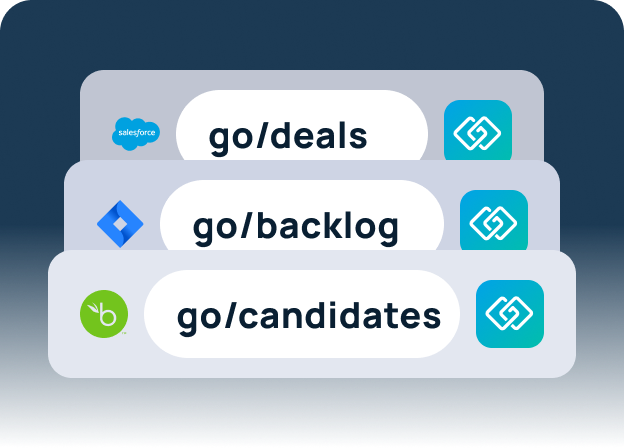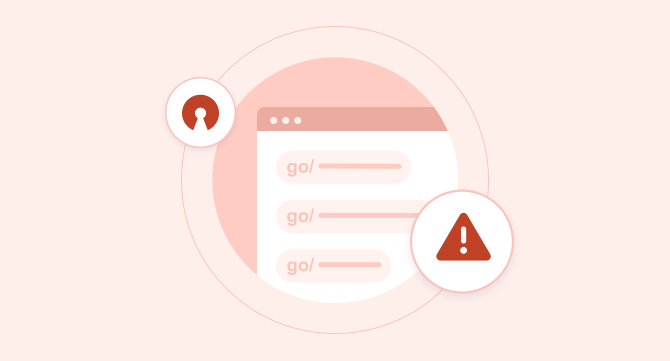Key Takeaways
- Open source go links tools often lack essential enterprise features like security, integrations, access controls, and centralized admin management.
- Technical debt is real. What looks cost-effective upfront can lead to long-term maintenance and support burdens on engineering teams.
- Scalability is limited. DIY systems struggle to support large teams, departments, or global growth.
- GoLinks offers a better alternative—with built-in security, seamless integrations, robust admin features, and a scalable, user-friendly experience from day one.
As companies scale and digital environments become more complex, fast access to internal knowledge becomes a competitive advantage. Go links—short, memorable URLs that direct employees to internal tools and resources—help teams stay aligned and productive.
When choosing a go links system, organizations face a key decision: build with open source tools or invest in a purpose-built platform.
While open source go links may seem cost-effective at first, they often have hidden challenges around reliability, security, and scalability. In this post, we’ll explore why growing teams are moving away from open source go links in favor of enterprise-ready solutions like GoLinks.
What Is an Open Source Go Links Tool?
An open source go links tool is typically a self-hosted, freely available codebase that allows users to create internal shortlinks—such as go/roadmap or go/hr—to navigate quickly to tools, documents, and resources. These systems are often developed and maintained by individual contributors or small open source communities, and they offer a degree of flexibility for teams that want to customize their setup.
Open-source GoLinks solutions can appeal to organizations with available engineering resources and a desire for full control over their infrastructure. Teams can tailor the system to their specific workflows, integrate with internal tools, and manage deployment on their own terms.
However, as adoption grows and more users rely on the system daily, those same teams often face serious challenges—from maintenance overhead and scalability issues to security, governance, and user support gaps.
Why Open Source Go Links Are Risky
1. Security and Compliance Gaps
Most open source go links systems miss the mark on enterprise-grade security and compliance, missing key features, including:
- Single sign-on (SSO) and multifactor authentication (MFA)
- Granular, role-based access controls
- Encryption for stored and transmitted link data
- Support for industry standards like SOC 2, ISO 27001, or GDPR
Without these safeguards, open source systems can pose serious risks—especially for organizations managing sensitive internal content such as product roadmaps, HR records, or financial documents. What begins as a simple internal tool can quickly become a liability if security and compliance aren’t built in.
Without these safeguards, open source systems can pose serious risks—especially for organizations managing sensitive internal content such as product roadmaps, HR records, or financial documents. What begins as a simple internal tool can quickly become a liability if security and compliance aren’t built in.
2. No Native Integrations
Enterprise tools should meet employees where they work—but most open source go links systems lack native integrations with common workplace platforms, such as:
- Slack or Microsoft Teams
- Google Workspace or Microsoft 365
- HR systems and project management tools
Without these integrations, teams are forced to context switch, and usage becomes fragmented. In contrast, GoLinks offers built-in integrations with the tools your teams already use—no custom development or workarounds required.
3. High Total Cost of Ownership
While open source go links tools may appear free initially, they often come with substantial hidden costs that can quickly add up. Significant engineering resources are required for:
- Initial setup and deployment
- Server maintenance and uptime monitoring
- Security patches and updates
- Supporting users and fixing bugs
This internal effort often exceeds the cost of using a purpose-built platform. And unlike commercial tools, open source projects may be abandoned at any time, leaving you without support.
4. Poor Scalability
Open source go links tools are generally built with small teams in mind. As organizations grow, their needs evolve to require features like:
- Analytics to track link usage and engagement
- Robust admin dashboards with granular permissions
- Ability to scale across thousands of users
Without these capabilities, managing an open source go links system becomes increasingly complex. Many organizations eventually need to replace their open source solution to meet growing demands.
5. No Visibility or Insights
Insight into how your organization uses go links is essential for making informed decisions and improving knowledge sharing. However, most open source go links tools lack built-in analytics or reporting features.
Without visibility into link usage, you’re left guessing:
- Which links are accessed most often
- What valuable knowledge is going unused
- Where gaps exist in your internal documentation
GoLinks gives administrators real-time visibility into usage patterns, enabling teams to optimize link management, identify knowledge bottlenecks, and drive better collaboration across the organization.
The Better Alternative to Open Source: GoLinks
GoLinks is a secure, scalable, enterprise-ready platform that eliminates the risks of open source go links. Trusted by companies of all sizes, GoLinks accelerates internal navigation, improves team alignment, and supports organizational growth.
With GoLinks, you get:
- Easy, natural language link creation accessible to all employees
- Built-in integrations with Slack, Google Workspace, Notion, and more
- Advanced admin controls and user management for governance and security
- Enterprise-grade security, including SSO and compliance with industry standards
- AI-powered search and discovery to maximize knowledge access and utilization
Whether you’re a fast-scaling startup or a large enterprise, GoLinks requires zero technical maintenance—letting your teams focus on driving business outcomes.
Why Teams Are Moving Away from Open Source Go Links
Open source go links work in simple environments. But as organizations grow, the limitations stack up—technical debt, manual maintenance, lack of security, and limited features all become barriers to productivity.
If your team is considering an open source go links tool, ask yourself: will it still serve us six months—or six years—from now?
For most teams, the answer is no.
Discover how GoLinks provides a secure, scalable, and alternative designed to support your growing team’s evolving needs. Learn more about GoLinks and start your free trial today.
Access and share resources instantly with GoLinks
Try for free














